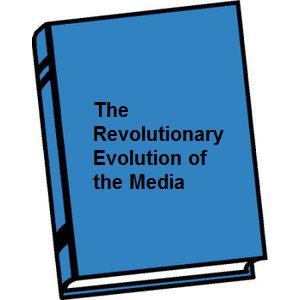“TREotM”: The Format Explosions

"The Revolutionary Evolution of the Media" -- Chapter 8, Part 4
Every week in the 1800s seemed to bring a new way to make media – then mostly print – more effective … and that pace just accelerated in the 20 th Century as new formats joined the innovations changing media.
As the 19th Century closed, many of the inventions of the latter couple of decades weren’t widely utilized by old and new media until the 1900s. Those included telephone, the movie camera, the Kodak camera, the linotype machine, the Kinetescope and mass market phonograph.
The telephone changed the transfer of information … and gave birth to: “Get me re-write.”
(But not everywhere. In 1917, the new rulers of the nascent Soviet Union of Socialist Republics decided the telephone was a bad idea … people might communicate among themselves. Instead of investing in linking people, the new Soviets decided to deploy loudspeakers in every newly “red” square. That need for control of the message continued through radio to television; that is, a much more controlled and consistent broadcast than just loudspeakers. Or, just louder loudspeakers. The Soviet republics had far fewer telephones than the rest of the world when the USSR collapsed. Oddly, when telephones did begin to take hold throughout the Soviet Union, all long distance traffic was routed through Moscow; only makes sense if the government wants to monitor and control one-to-one communication.)
The Kinetescope – or mini-movie – parlor opened in New York in 1894. Movies generally cost a nickel for a short visual experience. The nickel vis a vis the penny then commonly paid for papers set a precedent for movies costing much more than newspapers. The first truly economically successful movie was the French science fiction film A Trip to the Moon made by the former magician George Melies in 1902. It was also the first special effects movie. The next year, Edwin Porter’s The Great Train Robbery set in motion the romanticizing of the western making the myth of the West somewhat real. And one cannot forget Charlie Chaplin’s silent comedies of the ‘20s or the first (sort of, +/- 200 words) “talkie” with Al Jolson in The Jazz Singer.
In 1899 Nellie Bly beat Jules Verne’s “Around the World in 80 Days” and her exploits and other larger than life adventures helped the penny press thrive.
The two biggest movies of the first half of the 20th Century featured the War Between the States with Birth of Nation in 1915 and Gone with the Wind in 1939. The former ratified racism. The latter featured great stars and significant breakthroughs: Clark Gable, Vivien Leigh, Hattie McDaniel, Leslie Howard, George Reeves and Butterfly McQueen.
Animation from Walt Disney debuted in 1928 with Steamboat Willie. Big time staging arrived with Busby Berkeley and The Gold Diggersin 1933. The red scare showed up in the 1940s with Red Menaceand I Led Three Lives. The morality of it did better at the box office with High Noon. Orson Welles tour de force(wrote, produced, directed and starred) Citizen Kane debuted in 1941 to critical raves and tepid receipts. The all time (my vote anyway) best movie, Casablanca, featured Humphrey Bogart and Ingrid Bergman with all time great music, acting, story and lines (“Of all the gin joints …” and “I’m shocked, shocked to find that gambling is going on here!”).
The 1950s arrives and movies faced entertainment pressure from that growing, glowing box called a TV set. But first, radio.
Human voice was transmitted by radio waves to a receiver for the first time on June 3, 1900 in Sao Paulo, Brazil by Father Roberto Landell de Moura. He got a Brazilian patent on March 9,1901. The Brazilian government declined to help out, even after he received three US patents for a wave transmitter, a wireless telephone and a wireless telegraph on October 11, 1904. Sadly, nothing much happened afterward.
In 1901, Guglielmo Marconi sent and received the first radio message across the Atlantic. It used Morse code and it was point to point.
The first factory making radios was opened in 1912. A very busy year: the Titanic sank. Congress passed the Radio Act of 1912 mandating the continuous monitoring of distress signals by ships at sea. From Wikipedia: “Implementing and enforcing the Act was the responsibility of the United States Secretary of Commerce and Labor. The U.S. Department of Commerce and Labor was empowered to impose fines of not more than $500 and to revoke the licenses of those radio operators who violated the restrictions laid down by the Act. Furthermore, the government could seize the equipment of the offending station, as well as suspending the radio license of the operator for one year.” The Act set the standard for international and domestic licensing of radio by sovereign states.
Radio Corporation of America was founded in 1919 and the first radio stations in the US and Canada went on the air the next year. AT&T linked two stations 1923 creating the first “network.” Not so coincidentally, the A. C. Nielsen Company began figuring out ways to count listeners.
In the UK, the British Broadcasting Company was founded in 1922 as a single licensee in order to avoid the cacophony of multiple overlapping broadcasters that happened in the US. (Two years earlier, broadcasts from the Marconi base in Chelmsford led to complaints from the military and the station was taken off the air.) By 1922, some 100 broadcast licenses had been applied for … so the UK formed the BBC composed of manufacturers of receivers but that didn’t last long and the government formed its own company and absorbed the original BBC keeping the name.
The Radio Act of 1927 created the legal justification for the Federal Radio Commission, which morphed into the Federal Communications Commission in 1934 on heels of the invention of FM radio in 1933.
Next week: Chapter 8, Part 5 – Video in All Its Forms
In an almost 50-year career writing and reporting on media, Paul S. Maxwell started and/or ran some 45-plus publications ranging from CATV Newsweekly to Colorado Magazine to CableVision to Multichannel News to CableFAX and The BRIDGE Suite of daily newsletters and research publications. In between publishing stints, Maxwell served as an advisor and/or consultant to a number of major media companies and media start-ups including running a unit of MCI and managing a partnership of TCI and McGraw-Hill.
Send any and all criticisms, suggestions, rants, threats, corrections, etc. to him at cablemax@mac.com. He has a new Web site coming soon!
The opinions and points of view expressed in this commentary are exclusively the views of the author and do not necessarily represent the views of MediaBizBloggers.com management or associated bloggers. MediaBizBloggers is an open thought leadership platform and readers may share their comments and opinions in response to all commentaries.


